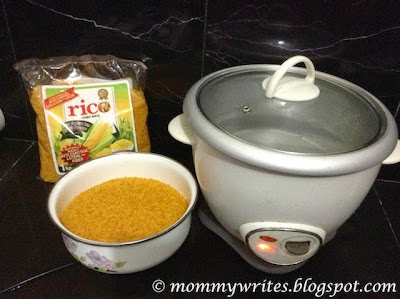By now, it has been established by studies that colored rice is definitely more nutritious than white rice. That is why health-conscious individuals have resorted to buying brown, red, and even black rice to make their diet healthier. From personal experience, I've observed that colored rice takes a really long time to prepare because I'd have to soak it first in water before I could cook it. Moreover, it costs a lot more than white rice.
 |
| easier to cook and healthier than other colored rice, promise! |
I did just that using our rice cooker and got perfectly cooked corn rice that we ate for dinner. To make the food presentation look better and more enticing to our boys, hubby used a cup to shape the corn rice before putting them on each plate. The verdict? Everyone liked the corn rice.
 |
| our family's first of many meals using corn rice |
This innovation is a result of La Filipina Uy Gongco Corporation's bright idea to put up state-of-the-art corn drying facilities in Bukidnon and Isabela last 2012. The company's aim was to provide farmers in the nearby areas to dry their corn safely (no longer just beside roads) and prevent the growth of aflatoxin, a fungus that loves moist environments and which can hamper growth in children and cause liver dysfunction in general.
Thus, the process of air-drying corn in the facilities kept moisture levels low, allowing the corn to be aflatoxin free. The drying facilities also helped stabilize corn supply and, consequently, prices, therefore helping farmers to maximize their revenue.
 |
| Step 1: Boil correct amount of water |
RiCo is made from 100% Philippine-grown corn. It has no cholesterol and has low glycemic index (a measurement of how fast blood sugar or glucose is absorbed in the bloodstream.) Low GI means slow and steady glucose absorption making RiCo ideal for diabetics, athletes, and those who simply want to eat more healthy.
 |
| Step 2: Pour RiCo rice onto boiling water |
I hope RiCo becomes more popular and find more consumers because I believe it will really help the Philippines be self-sufficient when it comes to staple food. Sure we continue to be a rice-producing country but we have become a rice importing nation since 2010 because of typhoons' damage to crops, the decreasing areas of farmlands, and the inability of rice farmers to produce enough for all Filipinos.
 |
| Step 3: Simmer until cooked |
The locally produced RiCo, a first from the Philippines, provides increased livelihood for our farmers and develops our country's natural resources. Help RiCo make its vision, of becoming part of the movement for healthy Filipino bodies and a healthy Philippine economy, come true.
 |
| Tube-feeding blenderized corn rice, meat, and veggies to my son with special needs |
For more information and recipes, visit www.yummyhealthy.ph, like www.facebook.com/yummyhealthylife, follow @yummyhealthylife on Instagram and @yummyhealthyph on Twitter.








No comments:
Post a Comment